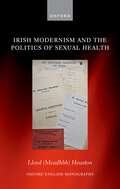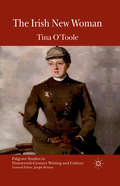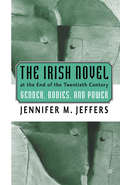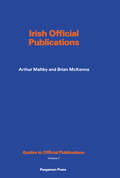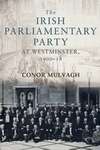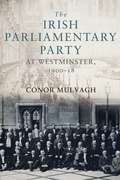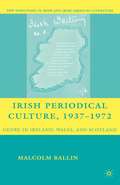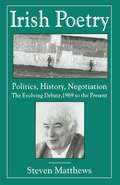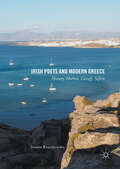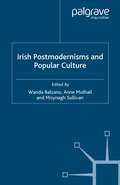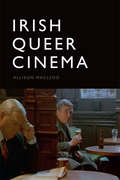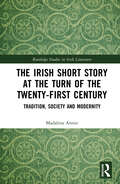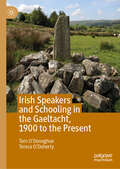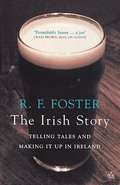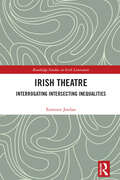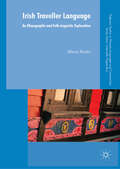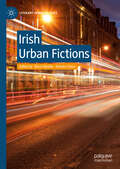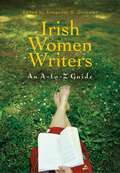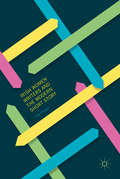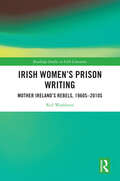- Table View
- List View
Irish Modernism and the Politics of Sexual Health (Oxford English Monographs)
by Lloyd (Meadhbh) HoustonIrish Modernism and the Politics of Sexual Health explores the politicized role of sexual health as a concept, discourse, and subject of debate within Irish literary culture from 1880 to 1960. Combining perspectives from Irish Studies, Modernist Studies, and the Social History of Medicine, it traces the ways in which authors, politicians, and activists in nineteenth- and twentieth-century Ireland harnessed debates over sexual hygiene, venereal disease, birth control, fertility, and eugenics to envisage competing models of Irish identity, culture, and political community. Analyzing the work of canonical authors (Yeats, Synge, Shaw, Joyce, Beckett, Flann O'Brien) and less often discussed figures (George Moore, Oliver Gogarty, Signe Toksvig, Kate O'Brien) in conversation with medical, scientific, and legal writing on sexual health, it charts how the medicalization and politicization of sex informed the emergence and development of modernism in Ireland. At the same time, by reading this literary material alongside the polemical and journalistic writing of figures such as Arthur Griffith, Maud Gonne, and Hanna Sheehy-Skeffington, it also reveals the ways in which key events in Irish cultural and political history - the Parnell Split, the Limerick Pogrom, the Playboy riots, the passage of the Censorship of Publications Act - were shaped by ongoing debates and dilemmas in the field of sexual health. This book will benefit students, researchers, and readers interested in the history of sex and its regulation in modern Ireland, the impact of sex and medicine on Irish political history, and the nature of modernism's engagement with sex, health, and the body.
Irish/ness Is All Around Us: Language Revivalism and the Culture of Ethnic Identity in Northern Ireland (Integration and Conflict Studies #6)
by Olaf ZenkerFocusing on Irish speakers in Catholic West Belfast, this ethnography on Irish language and identity explores the complexities of changing, and contradictory, senses of Irishness and shifting practices of 'Irish culture' in the domains of language, music, dance and sports. The author’s theoretical approach to ethnicity and ethnic revivals presents an expanded explanatory framework for the social (re)production of ethnicity, theorizing the mutual interrelations between representations and cultural practices regarding their combined capacity to engender ethnic revivals. Relevant not only to readers with an interest in the intricacies of the Northern Irish situation, this book also appeals to a broader readership in anthropology, sociology, cultural studies, history and political science concerned with the mechanisms behind ethnonational conflict and the politics of culture and identity in general.
The Irish New Woman (Palgrave Studies in Nineteenth-Century Writing and Culture)
by Tina O'TooleThe Irish New Woman explores the textual and ideological connections between feminist, nationalist and anti-imperialist writing and political activism at the fin de siècle . This is the first study which foregrounds the Irish and New Woman contexts, effecting a paradigm shift in the critical reception of fin de siècle writers and their work.
The Irish Novel at the End of the Twentieth Century: Gender, Bodies and Power
by J. JeffersThe Irish Novel at the End of the Twentieth Century: Gender, Bodies and Power interprets a wide variety of the most interesting Irish novels of the last ten years of the century from a perspective that focuses on the regulated sexual and constructed gendered body. The demarcating line of identity-the perennial Irish problem-can be gauged at the basic level of sexual and gender identity in contrast to or in alliance with political, social, religious or cultural norms. All mechanisms that have gone into controlling the body-gender regulation, violence, desire, religious taboos-can all be reinterpreted through the body in motion.
Irish Official Publications: A Guide to Republic of Ireland Papers, with a Breviate of Reports 1922–1972
by Arthur Maltby Brian McKennaGuides to Official Publications, Volume 7: Irish Official Publications provides a compilation of guidelines and summaries concerning Irish official publications. This book examines the bibliographical mysteries surrounding Republic of Ireland government publications.Organized into 10 classes, this book begins with an overview of the various categories of Irish official publications. This text then indicates how Irish official publications may be traced and acquired, and lists some libraries with good collections. This book discusses as well some important background information in terms and symbols and specimen pages are included to illustrate the transition of a serial from the British to the Free State administration. The reader is also introduced to the weekly and annual lists of government publications together with an example of a State-sponsored document.This book is a valuable resource for students and teachers.
The Irish Parliamentary Party at Westminster, 1900–18
by Conor MulvaghThe key to understanding the emergence of the independent Irish state lies in the history of Home Rule. This book offers the most comprehensive examination to date of the Irish Parliamentary Party (IPP) at Westminster during the years of John Redmond's chairmanship, 1900-18. The IPP were both the most powerful 'third party' and the most significant parliamentary challengers of the Union in the history of the United Kingdom up until the emergence of the Scottish National Party (SNP). These years saw the apparent triumph of the Home Rule cause when the Government of Ireland Act was signed into law in September 1914 but this false dawn led to the demise and electoral destruction of the IPP in 1918 when the party lost all but six seats to the political heirs of the 1916 Rising: Sinn Féin.
The Irish Parliamentary Party at Westminster, 1900–18
by Conor MulvaghThe key to understanding the emergence of the independent Irish state lies in the history of Home Rule. This book offers the most comprehensive examination to date of the Irish Parliamentary Party (IPP) at Westminster during the years of John Redmond's chairmanship, 1900-18. The IPP were both the most powerful 'third party' and the most significant parliamentary challengers of the Union in the history of the United Kingdom up until the emergence of the Scottish National Party (SNP). These years saw the apparent triumph of the Home Rule cause when the Government of Ireland Act was signed into law in September 1914 but this false dawn led to the demise and electoral destruction of the IPP in 1918 when the party lost all but six seats to the political heirs of the 1916 Rising: Sinn Féin.
Irish Periodical Culture, 1937-1972: Genre in Ireland, Wales, and Scotland (New Directions in Irish and Irish American Literature)
by M. BallinThis book examines periodical production in the context of post-revolutionary Ireland, employing the unique lens of genre theory in detailed comparisons between Irish, English, Welsh, and Scottish magazines.
Irish Poetry: The Evolving Debate, 1969 to the Present
by S. MatthewsThe award of the 1995 Nobel Prize for Literature to Seamus Heaney recognized not only the aesthetic achievement of his work, but also its political urgency. Here Steven Matthews presents a genealogy of Irish poetry which centres upon Heaney's recent preoccupation with the relations between poetry, politics and history. Writing from the perspective of Irish critical responses to the poetry, he discusses a wide range of work from John Hewitt through Heaney himself to Paul Muldoon. All of these poets have been inspired directly or indirectly by the situation in the North of Ireland. Placing the poems in their historical context, the author also analyses how these poets have reacted to the influence of W.B. Yeats. This important book offers a new approach to Irish poetry, linking it for the first time to the crucial political and historical events which lie at its centre.
Irish Poets and Modern Greece: Heaney, Mahon, Cavafy, Seferis
by Joanna KruczkowskaThis book explores the perception of modern Greek landscape and poetry in the writings of Seamus Heaney and Derek Mahon. Delving into travel writing, ecocriticism, translation and allusion, it offers a fresh comparative link between Greek modernity and Irish poetry that counterbalances the preeminence of Greek antiquity in existing criticism. The first section, devoted to travel and landscape, examines Mahon’s modern perception of the Aegean, inspired by his travels to the Cyclades between 1974 and 1997, as well as Heaney’s philhellenic relationship with mainland Greece between 1995 and 2004. The second section offers a close analysis of their C. P. Cavafy translations, and compares George Seferis’ original texts with their creative rendition in the writings of the Irish poets. The book will appeal to readers of poetry as well as those interested in the interactions between Ireland and Greece, two countries at the extreme points of Europe, in times of crisis.
Irish Postmodernisms and Popular Culture
by Wanda BalzanoThis collection explores popular culture in Ireland and Ireland in popular culture, from Fanfic to Orange Parades; from boybands to the Blessed Virgin Mary; from celebrity tourism to the Gaelic Athletic Association. The essays examine local and global Irishness, focusing on how gender, sexuality and race shape Irish 'postmodernity'.
Irish Queer Cinema
by Allison MacleodIdentifies an emerging genre within the contemporary Egyptian novel that reflects a new consciousness
The Irish Short Story at the Turn of the Twenty-First Century: Tradition, Society and Modernity (Routledge Studies in Irish Literature)
by Madalina ArmieIn the mid-1990s, Ireland was experiencing the "best of times". The Celtic Tiger seemed to instil in the national consciousness that poverty was a problem of the past. The impressive economic performance ensured that the Republic occupied one of the top positions among the world’s economic powers. During the boom, dissident voices continuously criticised what they considered to be a mirage, identifying the precariousness of its structures and foretelling its eventual crash. The 2008 recession proved them right. Throughout this time, the Irish contemporary short story expressed distrust. Enabled by its capacity to reflect change with immediacy and dexterity, the short story saw through the smokescreen created by the Celtic Tiger discourse of well-being. It reinterpreted and captured the worst and the best of the country and became a bridge connecting tradition and modernity. The major objective of this book is to analyse the interactions between fiction and reality during this period in Ireland by studying the short stories written by old and emergent voices published between the birth of the Celtic Tiger in 1995 up to its immediate aftermath in 2013.
The Irish Short Story at the Turn of the Twenty-First Century: Tradition, Society and Modernity (Routledge Studies in Irish Literature)
by Madalina ArmieIn the mid-1990s, Ireland was experiencing the "best of times". The Celtic Tiger seemed to instil in the national consciousness that poverty was a problem of the past. The impressive economic performance ensured that the Republic occupied one of the top positions among the world’s economic powers. During the boom, dissident voices continuously criticised what they considered to be a mirage, identifying the precariousness of its structures and foretelling its eventual crash. The 2008 recession proved them right. Throughout this time, the Irish contemporary short story expressed distrust. Enabled by its capacity to reflect change with immediacy and dexterity, the short story saw through the smokescreen created by the Celtic Tiger discourse of well-being. It reinterpreted and captured the worst and the best of the country and became a bridge connecting tradition and modernity. The major objective of this book is to analyse the interactions between fiction and reality during this period in Ireland by studying the short stories written by old and emergent voices published between the birth of the Celtic Tiger in 1995 up to its immediate aftermath in 2013.
Irish Speakers and Schooling in the Gaeltacht, 1900 to the Present
by Tom O'Donoghue Teresa O'DohertyThis book offers the first full-length study of the education of children living within the Gaeltacht, the Irish-speaking communities in Ireland, from 1900 to the present day. While Irish was once the most common language spoken in Ireland, by 1900 the areas in which native speakers of Irish were located contracted to such an extent that they became clearly identifiable from the majority English-speaking parts. In the mid-1920s, the new Irish Free State outlined the broad parameters of the boundaries of these areas under the title of ‘the Gaeltacht’. This book is concerned with the schooling of children there. The Irish Free State, from its establishment in 1922, eulogized the people of the Gaeltacht, maintaining they were pious, heroic and holders of the characteristics of an invented ancient Irish race. Simultaneously, successive governments did very little to try to regenerate the Gaeltacht or to ensure Gaeltacht children would enjoy equality of education opportunity. Furthermore, children in the Gaeltacht had to follow the same primary school curriculum as was prescribed for the majority English speaking population. The central theme elaborated on throughout the book is that this schooling was one of a number of forces that served to maintain the people of the Gaeltacht in a marginalized position in Irish society.
The Irish Story: Telling Tales and Making it Up in Ireland
by R F FosterEach of Foster's books has generated vigorous discussion, but in THE IRISH STORY he breaks fresh ground even by his own standards. Driven by his sense of the seriousness of history and a fascination with those who distort it, THE IRISH STORY examines how key facets of Ireland's past have been tampered with to serve a multiplicity of purposes. THE IRISH STORY is endlessly varied, surprising and funny. It is also a rallying cry for those anxious that contemporary Ireland may be in danger ofturning itself into a meretricious historical theme-park.
Irish Theatre: Interrogating Intersecting Inequalities (Routledge Studies in Irish Literature)
by Eamonn JordanThis book on modern and contemporary Irish theatre traces how social, cultural and economic capital are circulated in order to demonstrate complex and often contradictory outlooks on equality/inequality. Individual chapters analyse property ownership and inheritance; wealth acquisition; employment conditions; educational access; intercultural encounters; sexual intimacy and violation; and acts of resistance, protest and solidarity. This book addresses complex intergenerational, intercultural, racial, sectarian, ethnic, gender and inter- and intraclass dynamics from the perspective of ranked, objectifying, exploitative and coercive relationships but also in terms of commonalities, complicities, reciprocations and retaliations. Notable are the significances of wealth precarity and shaming; the consequences of anti-materialistic dramaturgical leanings; the pathologising of success; the fraught nature of solidarity; and the problematics of merit, divisive partitioning and muddled mésalliances. Ultimately the book wonders about how Irish theatre distinguishes between tolerable and intolerable inequalities that are culturally and socially but principally economically derived.
Irish Theatre: Interrogating Intersecting Inequalities (Routledge Studies in Irish Literature)
by Eamonn JordanThis book on modern and contemporary Irish theatre traces how social, cultural and economic capital are circulated in order to demonstrate complex and often contradictory outlooks on equality/inequality. Individual chapters analyse property ownership and inheritance; wealth acquisition; employment conditions; educational access; intercultural encounters; sexual intimacy and violation; and acts of resistance, protest and solidarity. This book addresses complex intergenerational, intercultural, racial, sectarian, ethnic, gender and inter- and intraclass dynamics from the perspective of ranked, objectifying, exploitative and coercive relationships but also in terms of commonalities, complicities, reciprocations and retaliations. Notable are the significances of wealth precarity and shaming; the consequences of anti-materialistic dramaturgical leanings; the pathologising of success; the fraught nature of solidarity; and the problematics of merit, divisive partitioning and muddled mésalliances. Ultimately the book wonders about how Irish theatre distinguishes between tolerable and intolerable inequalities that are culturally and socially but principally economically derived.
Irish Traveller Language: An Ethnographic and Folk-Linguistic Exploration (Palgrave Studies in Minority Languages and Communities)
by Maria RiederThis book explores the Irish Traveller community through an ethnographic and folk linguistic lens. It sheds new light on Irish Traveller language, commonly referred to as Gammon or Cant, an integral part of the community’s cultural heritage that has long been viewed as a form of secret code. The author addresses Travellers’ metalinguistic and ideological reflections on their language use, providing deep insights into the culture and values of community members, and into their perceived social reality in wider society. In doing so, she demonstrates that its interrelationship with other cultural elements means that the language is in a constant flux, and by analysing speakers’ experiences of language in action, provides a dynamic view of language use. The book takes the reader on a journey through oral history, language naming practices, ideologies of languageness and structure, descriptions of language use and contexts, negotiations of the ‘authentic’ Cant, and Cant as ‘identity’. Based on a two-year ethnographic fieldwork project in a Traveller Training Centre in the West of Ireland, this book will appeal to students and scholars of sociolinguistics, language in society, language ideology, folk linguistics, minority communities and languages, and cultural and linguistic anthropology.
Irish Urban Fictions (Literary Urban Studies)
by Maria Beville Deirdre FlynnThis collection is the first to examine how the city is written in modern Irish fiction. Focusing on the multi-faceted, layered, and ever-changing topography of the city in Irish writing, it brings together studies of Irish and Northern Irish fictions which contribute to a more complete picture of modern Irish literature and Irish urban cultural identities. It offers a critical introduction to the Irish city as it represented in fiction as a plural space to mirror the plurality of contemporary Irish identities north and south of the border. The chapters combine to provide a platform for new research in the field of Irish urban literary studies, including analyses of the fiction of authors including James Joyce, Roddy Doyle, Kate O’Brien, Hugo Hamilton, Kevin Barry, and Rosemary Jenkinson. An exciting and diverse range of fictions is introduced and examined with the aim of generating a cohesive perspective on Irish urban fictions and to stimulate further discussion in this emerging area.
Irish Women Writers: An A-to-Z Guide (Non-ser.)
by Alexander G. GonzalezIrish women writers have a large following, and their works are attracting large amounts of scholarly and critical attention. Through roughly 75 alphabetically arranged entries written by more than 35 expert contributors, this reference overviews the lives and works of Irish women writers active in a range of genres and periods. Each entry includes a brief biography, a discussion of major works and themes, a survey of the writer's critical reception, and a list of works by and about the author. The volume closes with a selected, general bibliography.Ireland has an especially lively literary tradition, and works by Irish writers have long been recognized as interesting and influential. While male writers have received the bulk of the critical attention given to Irish literature, contemporary women writers are among the most widely read Irish authors. This reference overviews the lives and works of Irish women writers active in a range of periods and genres.Included are roughly 75 alphabetically arranged entries written by more than 35 expert contributors. Among the writers discussed are: ; Elizabeth Bowen ; Mary Dorcey ; Lady Isabella Augusta Gregory ; Anne Hartigan ; Norah Hoult ; Paula Meehan ; Iris Murdoch ; Edna O'Brien ; Katharine Tynan ; Sheila Wingfield ; And many more.Each entry includes a brief biography, a discussion of major works and themes, a review of the writer's critical reception, and a list of works by and about the writer. The volume closes with a selected, general bibliography.
Irish Women Writers and the Modern Short Story
by Elke D'hokerThis book traces the development of the modern short story in the hands of Irish women writers from the 1890s to the present. George Egerton, Somerville and Ross, Elizabeth Bowen, Mary Lavin, Edna O’Brien, Anne Enright and Claire Keegan are only some of the many Irish women writers who have made lasting contributions to the genre of the modern short story - yet their achievements have often been marginalized in literary histories, which typically define the Irish short story in terms of its oral heritage, nationalist concerns, rural realism and outsider-hero. Through a detailed investigation of the short fiction of fifteen prominent writers, this study aims to open up this critical conceptualization of the Irish short story to the formal properties and thematic concerns women writers bring to the genre. What stands out in thematic terms is an abiding interest in human relations, whether of love, the family or the larger community. In formal terms, this book traces the overall development of the Irish short story, highlighting both the lines of influence that connect these writers and the specific use each individual author makes of the short story form.
Irish Women's Prison Writing: Mother Ireland’s Rebels, 1960s–2010s (Routledge Studies in Irish Literature)
by Red WashburnThis book explores 50 years of Irish women’s prison writing, 1960s–2010s, connecting the work of women leaders and writers in Northern Ireland during the Troubles. This volume analyzes political communiqués, petitions, news coverage, prison files, personal letters, poetry and short prose, and memoirs, highlighting the personal correspondence, auto/biographical narratives, and poetry of the following key women: Bernadette McAliskey, Eileen Hickey, Mairéad Farrell, Síle Darragh, Ella O’Dwyer, Martina Anderson, Dolours Price, Marian McGlinchey (formerly Marian Price), Áine and Eibhlín Nic Giolla Easpaig (Ann and Eileen Gillespie), Roseleen Walsh, and Margaretta D’Arcy. This text builds on different fields and discourses to reimagine gender and genre as central to an interdisciplinary and intersectional prison archive. Centering Irish women’s prison writings, in order to challenge canonization in history and literature, this volume argues that women’s lives and words offer a different view of gender and nation as well as offer a fuller and more inclusive archive of Irish history and literature. Additionally, this book will point to the ways in which their politics of everyday life and their cultural work is a form of anti-colonial civil rights feminism, for it speaks truth to power in a world in which compliance and silence are valued. Overall, this text focuses on rethinking and recasting women’s voices and words in order to document and promote the ongoing Irish freedom struggle from an abolitionist feminist perspective.
Irish Women's Prison Writing: Mother Ireland’s Rebels, 1960s–2010s (Routledge Studies in Irish Literature)
by Red WashburnThis book explores 50 years of Irish women’s prison writing, 1960s–2010s, connecting the work of women leaders and writers in Northern Ireland during the Troubles. This volume analyzes political communiqués, petitions, news coverage, prison files, personal letters, poetry and short prose, and memoirs, highlighting the personal correspondence, auto/biographical narratives, and poetry of the following key women: Bernadette McAliskey, Eileen Hickey, Mairéad Farrell, Síle Darragh, Ella O’Dwyer, Martina Anderson, Dolours Price, Marian McGlinchey (formerly Marian Price), Áine and Eibhlín Nic Giolla Easpaig (Ann and Eileen Gillespie), Roseleen Walsh, and Margaretta D’Arcy. This text builds on different fields and discourses to reimagine gender and genre as central to an interdisciplinary and intersectional prison archive. Centering Irish women’s prison writings, in order to challenge canonization in history and literature, this volume argues that women’s lives and words offer a different view of gender and nation as well as offer a fuller and more inclusive archive of Irish history and literature. Additionally, this book will point to the ways in which their politics of everyday life and their cultural work is a form of anti-colonial civil rights feminism, for it speaks truth to power in a world in which compliance and silence are valued. Overall, this text focuses on rethinking and recasting women’s voices and words in order to document and promote the ongoing Irish freedom struggle from an abolitionist feminist perspective.
